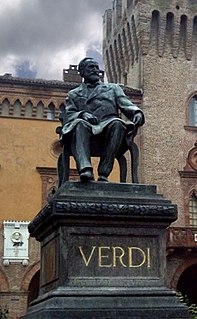
Mantua is a city and comune in Lombardy, Italy, and capital of the province of the same name.

Trieste is a city and seaport in northeastern Italy. It is located towards the end of a narrow strip of Italian territory lying between the Adriatic Sea and Slovenia, approximately 10–15 km (6–9 mi) southeast of the city. Croatia is about 30 km (19 mi) to the south.

Salerno is an ancient city and comune in Campania and is the capital of the namesake province. It is located on the Gulf of Salerno on the Tyrrhenian Sea. The city is divided into three distinct zones: the medieval sector, the 19th century sector and the more densely populated post-war area, with its several apartment blocks.
The year 1801 in architecture involved some significant events.

Busseto is a comune in the province of Parma, in Emilia-Romagna in Northern Italy with a population of about 7,100. Its history has very ancient roots which date back to the 10th century, and for almost five hundred years it was the capital of Stato Pallavicino, which eventually became part of the Duchy of Parma.

Macerata is a city and comune in central Italy, the county seat of the province of Macerata in the Marche region. It has a population of about 41,564.

The Teatro Lirico Giuseppe Verdi is an opera house located in Trieste, Italy and named after the composer Giuseppe Verdi. Privately constructed, it was inaugurated as the Teatro Nuovo to replace the smaller 800-seat "Cesareo Regio Teatro di San Pietro" on 21 April 1801 with a performance of Johann Simon Mayr's Ginevra di Scozia. Initially, the Nuovo had 1,400 seats. In 1821, it became known as the Teatro Grande.

The Barbaro family was a patrician family of Venice. They were wealthy and influential and owned large estates in the Veneto above Treviso. Various members were noted as church leaders, diplomats, patrons of the arts, military commanders, philosophers, scholars, and scientists.

Carlo Cossutta was a prominent Italian dramatic tenor of Slovene descent who had a major international opera career that spanned from the mid-1950s through the late 1990s. He began and ended his career at the Teatro Colón in Buenos Aires where he sang regularly from 1958 through 1998. He first drew international attention in 1964 when he sang the title role in the world premiere of Alberto Ginastera's Don Rodrigo, which led to a series of appearances at the Royal Opera, London during the 1960s. In the 1970s his international career skyrocketed with appearances at most of the major opera houses in Europe and the United States. He remained active on the international stage during the 1980s but his career slowed down significantly in the 1990s after he contracted liver cancer.

Giuseppe Bernardino Bison was an itinerant Italian painter of frescoes, landscapes, vedute, capriccios and some religious works.
Giuseppe Pistocchi (1744–1814) was an Italian architect of the Neoclassic style, active mainly near his natal city of Faenza.
Teatro Verdi may refer to:
Giuseppe Antonicelli was an Italian conductor who was highly active with Italy's leading opera houses from the 1920s through the 1950s. Among the houses he conducted at were, La Scala in Milan, the Teatro Regio di Torino, Teatro San Carlo in Naples, La Fenice in Venice, the Teatro Donizetti in Bergamo, the Teatro Nuovo in Turin, and the Teatro Lirico Giuseppe Verdi in Trieste. He also conducted a total of 158 performances at the Metropolitan Opera in New York City in 1948-1950.

Serbs in Italy or Italian Serbs, number 46,958 in Italy.

Saint Spyridon Church is a Serbian Orthodox church in Trieste, Italy.

Ferdinando Bonsignore was an Italian architect and designer.

The following is a compilation of memorials to the composer Giuseppe Verdi in the form of physical monuments and institutions and other entities named after him.

Cesare Maffei was an Italian painter of the Neoclassical period, active in Tuscany.

The Greek Orthodox Church of San Nicolò dei Greci, Trieste, Italy, is a historical Greek Orthodox Church built in 1784-1787 and re designed by architect Matteo Pertsch. The building is also known as the Greek Orthodox Church of San Nicholas and Most Holy Trinity. The iconostasis was painted by Spyridon Sperantzas

The Canal grande is a navigable canal located in the heart of the Borgo Teresiano, in the very center of the city of Trieste, approximately halfway between the railway station and Piazza Unità d'Italia.
This page is based on this
Wikipedia article Text is available under the
CC BY-SA 4.0 license; additional terms may apply.
Images, videos and audio are available under their respective licenses.






















